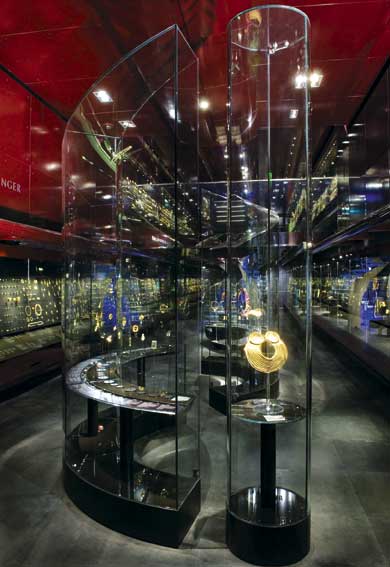
Travel
London's New Gem

Hang out with British friends for more than five minutes and you’re bound to hear the word “brilliant,” describing anything from the plot of a novel to a novel spatula design.
By: Ruth J. Katz
But step into the new William and Judith Bollinger Jewelry Gallery at the Victoria and Albert Museum in London, opened last May, and “brilliant” just may be the only word you can think of -- for the gleam and sparkle that dazzle the eyes, for the architecture that provides the canvas for the jewels and for the concept of the displays.
Fourteen million dollars and several years’ worth of planning and construction have transformed three cramped spaces -- the former home of the permanent jewelry collection -- into a glittering new exhibition hall. Walls were knocked down, opening the space up into a single chamber with 3,200 square feet to call its own. The gallery was designed by the London-based firm Eva Jiricna Architects, which also did the fine and designer jewelry retail areas at Harrods department store in London. 
The museum’s new hall is dramatic: It is clad almost entirely in black, with a black rubber floor, black leather seating and paneled walls of black fabric against which the jewels are displayed. These textures are offset by a striking spiral glass staircase. The organically shaped glass display cases curve down the center of the room, while the perimeter exhibits showcase a chronological history of 800 years of embellishment, starting in the Middle Ages.
Thirty-five hundred pieces, mostly jewelry but also gem-encrusted scabbard hilts, delicate sewing kits, Scandinavian bridal crowns and opulent Spanish hair ornaments, will engage even the most nonchalant viewers. It’s a collection worthy of sovereigns, and indeed, many pieces have come from crowned heads, including Queen Elizabeth I and Catherine the Great of Russia.
Among the jewelers are well-known names, like Faberge, Boucheron, Cartier and Tiffany, but countless pieces from anonymous makers are just as astonishing, such as a 19th-century Japanese bracelet constructed in intricately patterned panels of shakudo, an alloy of gold and copper, or a gold-enamel-and-pearl necklace found in a European castle, dating from the 17th century. There are simple, elegant pieces and others that are astonishingly intricate, like an 11-inch diamond “trembler” (each raised part is on its own individual spring and shimmies with the slightest movement) bodice ornament from the mid-19th century. Hand-wrought jewelry or body embellishments tend to be made from anything available, including materials that might startle, such as tin, aluminum, steel, the element niobium, braided and twisted human hair and bog oak.
If you want to take a little something home, you can design a ring on the premises in one of the several interactive computer installations, or hit the gift shop to buy special editions of contemporary jewelry created by some of the artists in the show.